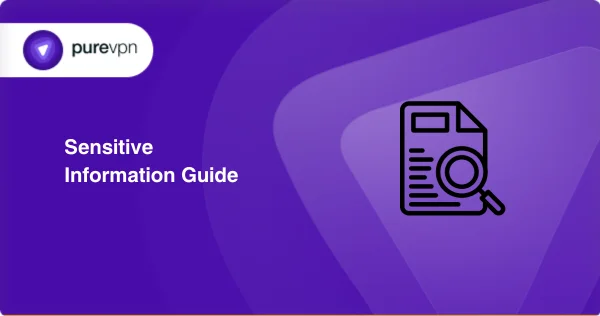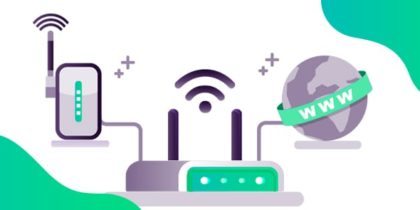Table of Contents
Do you know? 95 percent of data breaches are financially motivated, and it takes an average of 204 days to identify them. 91 percent of cybersecurity professionals reported increased cyber attacks due to remote working. All these breaches included sensitive information such as trade secrets, login credentials, financial transactions, and more. Knowing our first line of defense when protecting sensitive information is immensely important. Let’s go through this comprehensive, sensitive information guide to make you a pro in securing your personal and professional information.

What is Sensitive Information?
Sensitive information encompasses data that, if compromised, could result in harm, loss, or unauthorized access. Here’s a breakdown of what sensitive information might contain:
1. Personal Information
It includes names, addresses, phone numbers, and social security numbers.
2. Financial Data
Sensitive financial information involves bank account details, credit card numbers, and transaction records. Breaches can result in monetary losses and compromised financial stability.
3. Health Records
Medical histories, prescriptions, and other health-related information fall under this category. The exposure of such data can have severe consequences for individuals’ privacy and well-being.
4. Intellectual Property
Trade secrets, proprietary information, and patents constitute intellectual property. Unauthorized access could lead to loss of competitive advantage and financial setbacks for businesses.
5. Legal Documents
Legal information, including contracts, court records, and attorney-client privileged communications, demands stringent protection to maintain confidentiality and uphold legal rights.
6. Social Media Credentials
Usernames and passwords for social media accounts are sensitive, as they provide access to personal conversations, photos, and potentially sensitive information shared on these platforms.
7. Biometric Data
Fingerprints, facial recognition data, and other biometric identifiers are increasingly used for authentication.
8. Employee Records
Employee details, payroll information, and performance evaluations fall under this category. Breaches can lead to identity theft and compromise of sensitive corporate data.
9. Customer Information
Customer names, addresses, and purchase history are sensitive details for businesses. Unauthorized access to this information can lead to reputational damage and loss of customer trust.
10. Classified Government Information
Government agencies handle classified information, the exposure of which can pose threats to national security. Proper classification and protection are paramount.
How to Assess Your Risk
Risk assessment includes potential weak points or susceptibilities in your information security infrastructure. Risks for individuals and companies are different. The idea is to assess them efficiently.
Here’s how we can break down the assessment process:
Identifying Vulnerabilities
Identifying vulnerabilities is one of the most crucial steps to securing sensitive information. Analyzing your system, processes, and all areas of importance, including personnel, is vital.
This lays the groundwork for a robust defense mechanism.
Conducting a Risk Assessment
Once vulnerabilities are identified, the next step involves systematically evaluating the potential risks associated with these weaknesses.
This assessment considers the likelihood of a security breach and its potential impact on sensitive information. We can allocate resources to address the most critical areas by assigning priority levels to different risks.
Recognizing High-Risk Scenarios
Not all risks are created equal. It is crucial to differentiate between scenarios with varying degrees of severity. High-risk situations demand heightened attention and resources.
These could include external threats like sophisticated cyberattacks or internal risks like data leaks.
4 Tier Sensitive Information Protection Pro Analysis
Personal Information Protection
In safeguarding your personal information, let’s discuss some practical and user-friendly measures to fortify your digital defenses.
Password Management
Managing passwords is the most critical aspect of protecting your personal information. Regularly updating passwords and avoiding easily guessable combinations can act as your first tool to secure data.
Two-Factor Authentication
Unauthorized access can be effectively managed with two-factor authentication, which acts as a double-check to keep your credentials safe.
Safe Internet Browsing Habits
Adopting safe browsing habits is equally important. Be wary of suspicious links, only download from trusted sources, and keep your software updated. You can create a secure online environment for you and your family by exercising caution.
Social Media Privacy Settings
Keeping your privacy private to yourself is essential. Managing all your social media accounts with double check on posts, friend list, and who can view your profile is all that matters.
Regularly review and update the settings to ensure you only share information with those you trust.
Safeguarding Financial Information
Online Banking Security
Set up account alerts to receive transaction notifications, enabling you to identify any suspicious activity promptly. Ensure secure and unique login credentials are used, and consider the added protection of Two-Factor Authentication.
By treating your online banking like an asset, you enhance the security of your financial stronghold.
Credit Card Safety Measures
Safeguard your statements for unauthorized transactions. Opt for credit cards with advanced security features, such as EMV chips, which provide additional protection. Additionally, promptly report lost or stolen cards to your financial institution to mitigate potential risks.
Recognizing Phishing Attempts
Sharpen your ability to recognize phishing attempts by scrutinizing emails, messages, or websites for suspicious elements. Legitimate financial institutions won’t ask for sensitive information via email. If something feels off, verify the source independently.
Protecting Health Information
Importance of Health Data Security
Securing health information is fundamental not only for privacy but also for maintaining trust in healthcare systems.
HIPAA Compliance
This involves strict adherence to protocols, ensuring the confidentiality of patient data, and implementing safeguards against unauthorized access.
By aligning with HIPAA, you not only comply with legal requirements but also improve the overall security posture of health information.
Secure Health-related Apps and Devices
Choose apps and devices with robust security features, such as data transmission and storage encryption. Regularly update these tools to patch potential vulnerabilities.
By embracing secure health-related technologies, you reinforce the protective measures around your health information.
Securing Professional Data
Workplace Cybersecurity Policies
Clearly defined and communicated policies serve as the blueprint for safeguarding professional data. These policies should encompass password protocols, access controls, and data handling procedures.
Regularly review and update these policies to adapt to evolving cyber threats. By laying down the rules of engagement, you fortify the overall security posture of professional data within your organization.
Employee Training and Awareness
Conduct regular training sessions to educate employees about cybersecurity best practices, identifying phishing attempts, and the importance of data confidentiality.
Encryption and Secure Communication
Implementing encryption protocols ensures that even if unauthorized access occurs, the data remains unintelligible without the proper decryption keys. Extend this practice to secure communication channels within and outside the organization.
Understanding Sensitive Information Protection Techniques
Data Encryption and Secure Communication
Understanding Encryption
When you send information, it transforms into an unreadable format using a mathematical algorithm.
This encrypted data can only be deciphered by someone with the correct key. Understanding encryption protocols and tools is important.
Utilizing Secure Communication Channels
Opt for communication channels that prioritize security. These channels employ protocols like HTTPS for web communication or encrypted email services.
Using a VPN with advanced protocols is also a way out if you are an individual or run a company. Choosing the right VPN also matters, as you must only invest in reliable companies to protect your information completely.
Legal Aspects of Information Protection
Data Protection Laws and Regulations
These regulations, such as GDPR or CCPA, dictate how organizations handle personal information. Complying with data protection laws ensures that personal data is handled responsibly, with transparency about its collection, use, and storage.
You must know about the implications and criticalities of these regulations if you are traveling or handling business internationally.
Consequences of Non-Compliance
Compliance with international regulations and community standards is of great importance. If you do not comply with standards, the legal and commercial consequences might affect your data management.
Privacy Policies and User Agreements
Privacy policies and user agreements are the terms and conditions of digital significance. These documents outline how user data will be handled and set expectations for both parties.
By prioritizing clear communication, you build trust with your partners, users, and all the people associated with your business.
Incident Response and Recovery
Developing this plan involves identifying potential incidents, establishing clear roles and responsibilities, and defining a step-by-step process for response. It’s like having a fire drill but for digital emergencies.
Proactively creating and regularly updating this plan will equip your team with a roadmap to respond to unexpected incidents swiftly.
Emerging Technologies and Information Security
Blockchain Technology
Blockchain technology has developed the most advanced solutions to protect data. Recognizing the potential of blockchain technology in data management has led many professionals to the most secure environment.
From financial transactions to supply chain management, innovative and secure ways of handling information are what we need.
Artificial Intelligence in Cybersecurity
Understanding AI in cybersecurity is about leveraging its power to enhance threat detection, response, and mitigation.
Integrating AI can empower defenses with a proactive and adaptive layer against evolving cyber threats.
IoT Security Measures
Implementing IoT security measures includes regularly updating device firmware, using strong authentication, and segmenting IoT networks. By adopting these measures, you ensure that the conveniences offered by IoT devices come with a robust layer of security.
Future Trends in Information Security
Biometric Authentication
Biometric technologies offer a promising future for robust user identification. Fingerprint, facial recognition, and even behavioral biometrics are becoming integral components of secure access systems.
Quantum Computing and Encryption
Quantum computers have the potential to break current encryption algorithms, and there is a simultaneous race to develop quantum-resistant cryptographic solutions.
As organizations prepare for a post-quantum era, the intersection of quantum computing and encryption emerges as a pivotal area in future information security strategies.
No Book of Rule Fits All!
Cybersecurity threats are constantly in flux, demanding a proactive and adaptive approach. With the rise of sophisticated threat actors and the increasing interconnectivity of systems, the evolution of cyber threats is inevitable.
Future trends suggest a continued diversification of attack vectors, focusing on exploiting emerging technologies such as IoT and AI.
Cybersecurity measures must evolve in tandem, incorporating threat intelligence, machine learning, and behavioral analysis to effectively anticipate and mitigate changing threats.
No strategy fits all goals; remember to develop your first line of defense as a go-to solution to secure your sensitive information.



